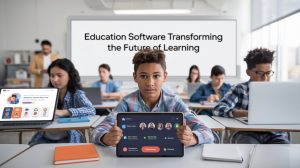Chat GPT Plus subscription BD
৳499.00 – ৳1,999.00Duolingo Premium Plus Subscription
৳399.00 – ৳1,290.00Education Software Transforming the Future of Learning
1. Introduction
Education software has revolutionized the way students learn and teachers instruct. With the rise of digital learning, software applications enhance traditional education, making it more interactive, accessible and practical. Whether used in schools, Universities or corporate training programs, education software has become essential in modern learning environments.
2. What is Education Software?
Definition and Scope
Education software refers to digital programs and applications facilitating teaching and learning. These tools can be used for classroom management, online learning, student information systems, language learning, and more.
Education software consists of digital programs and applications that help students learn and assist teachers in managing classrooms. These tools make learning more accessible, engaging, and effective. Many schools, colleges and online platforms use education software to improve teaching methods.
Education software serves different purposes. Some programs help teachers organize lessons and track student progress. Others provide students with interactive learning experiences through videos, quizzes and virtual activities. There are also applications for language learning, exam preparation and subject-specific training.
Types of Education Software
There are various types of education software, including:
- Learning Management Systems (LMS) – Platforms for managing online courses.
- Student Information Systems (SIS) – Software for tracking student progress.
- Classroom Management Software – Tools for teachers to organize classroom activities.
- Educational Games – Interactive games that enhance learning.
- Language Learning Software – Apps that help learners master new languages.

Key Features and Functionalities
- Personalization: Adapts to individual learning needs.
- Interactive Learning: Engages students through multimedia content.
- Progress Tracking: Monitors student performance and provides analytics.
- Collaboration Tools: Enables communication between students and teachers.
3. Benefits of Education Software
Personalized Learning Experiences
Education software allows students to learn at their own pace. Adaptive learning technologies personalize the experience, ensuring that each student receives content suited to their level.
Accessibility and Flexibility
With online learning platforms, students can access educational materials anytime and anywhere. This flexibility is especially beneficial for remote learners and working professionals.
Interactive and Engaging Learning
Many education software solutions incorporate gamification, multimedia and interactive simulations to keep students engaged. This makes learning more enjoyable and effective.
4. Types of Education Software
4.1 Learning Management Systems (LMS)
A Learning Management System (LMS) is a platform that helps educators create, manage and deliver online courses.
Popular LMS Platforms:
- Moodle – An open-source LMS used by universities.
- Canvas – A user-friendly LMS with extensive integrations.
- Google Classroom – A free LMS for schools and educators.
Benefits of LMS:
- Centralized learning materials
- Automated assessments and grading
- Easy tracking of student progress
4.2 Student Information Systems (SIS)
A Student Information System (SIS) helps educational institutions manage student records, attendance, grades and administrative tasks.
Features of SIS:
- Enrollment and registration management
- Grade tracking and report generation
- Attendance monitoring
Examples of SIS:
- PowerSchool – A popular SIS for K-12 schools.
- Infinite Campus – Used for school district management.
4.3 Classroom Management Software
Classroom management software assists teachers in organizing lessons, monitoring student activities and maintaining discipline.
How It Supports Teachers:
- Screen monitoring to prevent distractions
- Automated attendance tracking
- Assignment scheduling and reminders
4.4 Online Course Platforms
Online course platforms allow individuals and institutions to create and sell courses.
Best Online Course Providers:
- Udemy – Offers courses on various subjects.
- Coursera – Partners with universities for professional courses.
- Khan Academy – Provides free educational resources.
4.5 Educational Games and Simulations
Gamified learning improves student engagement and retention.
Popular Educational Games:
- Duolingo – A language-learning app with game elements.
- Minecraft: Education Edition – Helps students learn coding, math and science.

4.6 Language Learning Software
Language learning apps help students acquire new languages through interactive exercises.
Best Language Learning Apps:
- Rosetta Stone – Uses immersive learning techniques.
- Babbel – Offers structured language courses.
- Busuu – Includes AI-powered language lessons.
- Grammarly– Grammarly is an AI-powered writing assistant that checks grammar, spelling and style.
- Chat GPT– ChatGPT is an AI-powered chatbot that generates human-like text responses and assists with various tasks.
5. How Education Software Enhances Learning
Adaptive Learning Techniques
AI-driven education software adapts to student progress and provides personalized recommendations.
AI and Machine Learning Integration
Artificial Intelligence helps automate assessments, offer real-time feedback and generate customized learning paths. Examples- Chat GPT, Gemini, DeepSeek etc.
Real-Time Feedback and Analytics
Education software provides insights into student performance, helping teachers identify learning gaps and improve lesson plans.
6. Key Features of Effective Education Software
6.1 User-Friendly Interface
A well-designed education software should have an intuitive interface that is easy to navigate for both students and teachers.
Importance of Intuitive Design
- Reduces the learning curve for users
- Ensures accessibility for all age groups
- Enhances user engagement and satisfaction
Examples of Well-Designed Education Software
- Google Classroom – Simple, clean interface for easy navigation
- Khan Academy – Organized course structure with transparent progress tracking
6.2 Customization and Personalization
Education software should be able to adapt to different learning styles and preferences.
Adaptive Learning Paths
- AI-driven recommendations based on student performance
- Dynamic adjustments to course difficulty
- Personalized quizzes and assignments
Importance of Tailored Learning Experiences
- Increases student motivation and engagement
- Helps slow learners progress at their own pace
- Provides advanced learners with additional challenges
6.3 Integration with Other Tools
Education software should be compatible with other digital tools and platforms used in learning environments.
Importance of API Support
- Enables seamless data transfer between applications
- Enhances collaboration between different software solutions
- Improves workflow for educators and students
Examples of Compatible Tools
- LMS Integration with Zoom for live classes
- Google Docs and Microsoft Teams for collaboration
- AI-Powered Grading Systems for automated assessments
6.4 Security and Data Privacy
With the rise of digital learning, protecting student data is a top priority.
Compliance with Regulations
- GDPR (General Data Protection Regulation) – Protects student information in Europe
- FERPA (Family Educational Rights and Privacy Act) – Regulates student data privacy in the U.S.
Best Practices for Secure Education Software
- End-to-end encryption for student data
- Multi-factor authentication for access control
- Regular security updates and compliance checks
6.5 Mobile Compatibility and Accessibility
In today’s mobile-driven world, education software must be accessible across devices.
Role of Mobile Learning
- Allows students to learn anytime, anywhere
- Provides flexibility for working professionals and remote learners
- Enhances engagement through mobile-friendly interfaces
Best Mobile-Friendly Education Software
- Duolingo – Language learning app with a mobile-first approach
- Coursera Mobile App – Offers full course access on smartphones.
- Google Classroom – Allows teachers to assign tasks via mobile device.s
7. Challenges of Implementing Education Software
7.1 Cost and Budget Constraints
Many schools and institutions struggle with the financial burden of purchasing and maintaining education software.
Potential Solutions:
- Open-source alternatives like Moodle and OpenEdX
- Government and nonprofit funding programs
- Subscription-based pricing models with discounts for schools
7.2 Resistance to Technology Adoption
Some educators and students may be hesitant to use digital tools due to lack of familiarity or preference for traditional methods.
Ways to Overcome Resistance:
- Providing comprehensive training sessions
- Demonstrating software benefits through case studies
- Offering technical support for users
7.3 Need for Training and Support
Many educators require training to effectively integrate technology into their teaching.
Solutions:
- Online tutorials and video guides
- Dedicated support teams from software providers
- Peer mentoring and teacher-led workshops
7.4 Technical Issues and Software Maintenance
Frequent software updates, bugs and system downtime can disrupt learning.
Ways to Minimize Technical Challenges:
- Choosing well-supported, reliable platforms
- Ensuring strong internet connectivity in classrooms
- Regular maintenance and backup systems

8. Future Trends in Education Software
8.1 Artificial Intelligence and Machine Learning
AI is playing an increasingly important role in personalizing education and automating tasks.
AI-Powered Innovations in Education
- Smart Tutors: AI-driven chatbots providing instant assistance
- Automated Grading: AI assessing assignments and quizzes
- Predictive Analytics: Identifying students who need extra help
8.2 Virtual and Augmented Reality in Education
VR and AR are transforming the way students interact with learning materials.
Best VR/AR Tools in Education
- Google Expeditions: Virtual field trips for students
- zSpace: Interactive 3D learning experiences
- Merge Cube: AR-powered educational simulations
8.3 Blockchain in Education
Blockchain technology is being used to secure student records and certificates.
Real-World Applications of Blockchain in Education
- Tamper-Proof Diplomas: Universities using blockchain for credential verification
- Decentralized Learning Platforms: Students control access to their academic records
- Secure Data Sharing: Blockchain ensures privacy and data security
8.4 Gamification and Interactive Learning
Game-based learning techniques are making education more fun and effective.
Benefits of Gamification in Education
- Increases student engagement
- Encourages competition and motivation
- Enhances knowledge retention through interactive experiences
Best Gamified Education Software
- Classcraft: RPG-style learning experience for classrooms
- Kahoot!: Quiz-based learning game for interactive assessments
- Prodigy: Math-focused adventure game for students
9. How to Choose the Right Education Software
9.1 Identifying Learning Objectives
Before selecting education software, it’s important to define learning goals and requirements.
9.2 Checking Software Reviews and Ratings
Reading user feedback and industry reviews helps in making an informed decision.
9.3 Ensuring Scalability and Flexibility
The software should be adaptable to growing educational needs and technological advancements.
9.4 Considering Budget and Support Options
It’s important to balance cost with features, ensuring that support is readily available.
Get Started with Shopinbd’s Education Software Today!
Are you searching for a trusted education software solution in Bangladesh? Shopinbd provides advanced tools that improve online learning, help manage students more efficiently and simplify administrative work.
Shopinbd's expertise in education technology is evident in its user-friendly platform, which is built with industry best practices. The software integrates advanced learning management tools, making it easier for institutions to adapt to modern educational demands. With a Good reputation in the market, it has gained the trust of students, educators and institutions across Bangladesh.
If you are looking for a solution that combines experience, expertise and reliability, Shopinbd might be the right choice.
- Why Choose Shopinbd?
- Affordable and scalable solutions
- Mobile-friendly and cloud-based accessibility
- Easy purchase way.
- 100% Official Educational Software
- Monthly & Yearly subscription
- Money Back Guarantee
Take your education life to the next level with Shopinbd’s Education Software. Contact us today for a demo and see how we can help revolutionize learning in Bangladesh!
10. Conclusion
Education software has transformed the way we learn, offering personalized, interactive and flexible solutions for students and Teachers. From AI-driven adaptive learning to blockchain-secured certifications, technology continues to shape the future of education. Choosing the right education software will improve learning outcomes as more institutions embrace digital learning.
11. FAQs
1. What is the best education software for schools?
The best education software depends on the school’s needs. Google Classroom, Moodle and Blackboard are popular choices for managing classrooms and online courses.
2. How does education software benefit students?
Education software provides personalized learning, interactive experiences and flexible access to educational materials, improving engagement and retention.
3. What are the key features to look for in an education app?
Key features include user-friendliness, personalization, mobile compatibility, data security and integration with other learning tools.
4. How can teachers integrate education software into the classroom?
Teachers can use software for lesson planning, grading, virtual classrooms and interactive activities to enhance student engagement.
5. What is the future of education technology?
The future of education technology includes AI-driven personalized learning, VR/AR-based simulations, gamification and blockchain-secured credentials.

